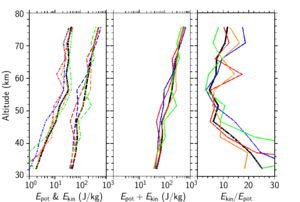Simultaneous Wind and Temperature Measurements by Lidar
The instrumental setup of the ALOMAR RMR lidar allows to measure wind speeds and temperatures in the middle atmosphere simultaneously. For the temperature retrieval the measured altitude profile of backscatter signal is transformed into a profile of air density, from which a temperature profile is calculated. The wind retrieval relies on measuring the Doppler shift of light which is backscattered by moving air molecules. The method uses the steep edge of an absorption line of molecular iodine to resolve small frequency variations of the backscattered light. While temperatures were measured routinely since 1997, wind observations were performed only since 2009.
To study gravity waves, whose periods are some hours, long, continuous observations are favorable. However, the duration of lidar observations is limited mostly by weather conditions. In January 2012 the ALOMAR RMR lidar was operated continuously for just under 60 hours. Pronounced wave structures in temperature and wind were detected during this observation.

The figure shows time-height sections of the temperature and zonal wind deviation in the altitude range from 30 to nearly 80 km during the 60 hours long observation in January 2012. The reduced top altitude between about 8 and 15 UT is caused by stray light from the Sun. During the last day clouds disturbed the observation. However, this is the first simultaneous observation of gravity waves in temperature and wind over such a large altitude range during such a long time. The temperature and wind perturbations show similar wave structures. However, there is a shift in time and altitude between maxima of the temperature and wind deviations. Additionally, the phases in temperature deviation are slightly steeper in most cases. The observed period of the wave structures is about 10 to 17 h. However, the actual, intrinsic, period of the gravity waves is shorter: Since the wave structure is advected by the background wind, its period is shifted (Doppler effect). Hence, the intrinsic period can be derived only if the background wind is known; it is about 6 to 11 h. Although some wave structures are very prominent, the observed temperature and wind perturbations are caused by the superposition of an ensemble of several different waves.
The energy of a gravity wave consist of their potential energy (which is described by the temperature deviations) and their kinetic energy (which manifests in the wind deviations). Both depend differently on the intrinsic period of the gravity wave. Hence, it is possible to derive the intrinsic period of the gravity wave ensemble from simultaneous observations of wind and temperature with the same temporal and spatial resolution. The figure shows the potential, kinetic and total gravity wave energy density and the ratio of kinetic to potential energy density. As expected, the energy density increases exponential with altitude. The decrease of the ratio of kinetic to potential energy density corresponds to a decrease of the intrinsic period of the gravity wave ensemble from about 12.3 h to about 11.1 h. This indicates that at higher altitudes more energy is on perturbations with smaller scales.













